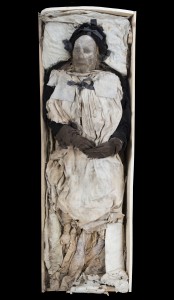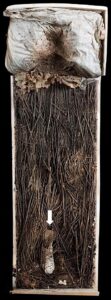 Peder Winstrup (1605–1679), Bishop of Lund, was buried in the family crypt in Lund Cathedral in January 1680. The theologian and Lutheran bishop son of a theologian and Lutheran bishop, Winstrup had been ennobled by King Charles X Gustav in 1658 and was entombed with a wealth of fine accoutrements from clothing — a velvet cape, leather gloves — to bedding. The inner coffin was padded with herbaceous plants covered by a silk lining. His head rested on two pillows. When the coffin was opened in the 19th century, Winstrup’s body was found to have been naturally mummified and the other organic materials were also in an excellent state of preservation.
Peder Winstrup (1605–1679), Bishop of Lund, was buried in the family crypt in Lund Cathedral in January 1680. The theologian and Lutheran bishop son of a theologian and Lutheran bishop, Winstrup had been ennobled by King Charles X Gustav in 1658 and was entombed with a wealth of fine accoutrements from clothing — a velvet cape, leather gloves — to bedding. The inner coffin was padded with herbaceous plants covered by a silk lining. His head rested on two pillows. When the coffin was opened in the 19th century, Winstrup’s body was found to have been naturally mummified and the other organic materials were also in an excellent state of preservation.
His coffin was removed in 2012 for reburial in a cemetery, but because his remains were known to be unusually well-preserved, a multi-disciplinary team of researchers from Lund University and the Lund University Historical Museum was authorized to study Winstrup’s body and the contents of his coffin. A CT scan revealed surprising information: a bundle below the bishop’s right tibia contained the remains of 5-6-month-old fetus.
 At the time of the discovery, researchers speculated that the fetus could have been hidden in the coffin by a family member, a member of his staff or by the embalmers. There was a practice in 17th century Scandinavia of bribing cemetery employees to bury babies who had died before baptism to give them the chance to be interred in consecrated ground. The stealth burial of an unrelated fetus in the bishop’s coffin could have been accomplished as it was accessible in the family crypt, and the position of the little one’s body — squeezed under the silk lining disturbing the plants and the bishop’s legs — suggests it was hastily stashed, not reverently laid to rest. The disarray of the bedding and bishop’s lower legs in that area indicates the fetus was added to the coffin after the funeral and deposition in the vault.
At the time of the discovery, researchers speculated that the fetus could have been hidden in the coffin by a family member, a member of his staff or by the embalmers. There was a practice in 17th century Scandinavia of bribing cemetery employees to bury babies who had died before baptism to give them the chance to be interred in consecrated ground. The stealth burial of an unrelated fetus in the bishop’s coffin could have been accomplished as it was accessible in the family crypt, and the position of the little one’s body — squeezed under the silk lining disturbing the plants and the bishop’s legs — suggests it was hastily stashed, not reverently laid to rest. The disarray of the bedding and bishop’s lower legs in that area indicates the fetus was added to the coffin after the funeral and deposition in the vault.
In order to determine whether the fetus was in any way related to the bishop, researchers at Stockholm University analyzed samples of DNA from the bishop’s right femur and the fetus’ left femur. They were found to share 25% of their genes, a second-degree kinship. Mitochondrial DNA analysis found no commonalities, but there was a match on the Y-chromosome, so they were closely related through the male line.
Genealogical research through the paternal family was able to exclude several possibilities. Peder’s only brother died at age 25 unmarried and childless, so that eliminated uncles and nephews. Of Peder’s own surviving children (two daughters and a son), one daughter died before marriage and the other, Anna Maria, died while pregnant with twins. Enter the bishop’s son, Peder Pedersen Winstrup. He did not follow in the family business, but rather studied mathematics and military fortification. He married in 1679 and inherited the estates of both his father and his father-in-law.
The gravy train came to an abrupt end. Shortly after his father’s burial, Peder Pedersen was immiserated in the Great Reduction of 1680 when Swedish King Charles XI reclaimed lands formerly granted to the nobility. By 1700, Peder and his wife were reduced to living on charity from her brother. He died without issue, the last male in the Winstrup line.
With the results from the aDNA analysis at hand and the genealogy, the only person able to provide a second-degree relative to Peder Winstrup through paternal lineage was his son, Peder. The foetus of a boy placed in the coffin could thus be the grandson of the bishop. It seems probable that the relatives would have had access to the crypt where the coffins of the Winstrup’s were stored and, thus, a possibility to deposit the foetus in one of the coffins, in this case that of Peder Winstrup.
The study has been published in the Journal of Archaeological Science: Reports and can be read in its entirety here.
Good Lord, what is wrong with these guys!? :ohnoes:
First, no dunes at all but only “twigs” in his coffin, and now they evict him out of his own family crypt? In order to do what with, exactly? –And, where did the grandson end up?
(Maybe not so funny) Fun Fact:
Just two years ago, I found out where my own grandfather was buried. Apparently, it is a now defunct former cemetery in the dunes at the Baltic Sea, and it really looks great. Also, but already in 1640, someone whom I am with a certain likelihood related to, was executed with what is referred to as “Swedish drink” :skull:
——–
PS: Actually, ‘natural mummification’ is the whole idea of running a family crypt in the first place, and over here, they usually work quite well, i.e. until some plumber closes a few crucial openings for air circulation. In case bodies are researched on, they usually go back in there.
And hyre cometh the plumber,
The dull thud of hys grey bell,
To rot ye well under sand or sod.
😉
——-
A joyfull heart
causeth good humor:
But only a sorowfull
minde dryeth a bodie.
——-
Source: Geneva Bible 1587, Proverbs 17-22: The Latin verb “humor” = ‘I am laid to rest’.
(…as a noun, we have ‘sogginess’. Any other possible meaning would of course be sheer coincidence :yes: )